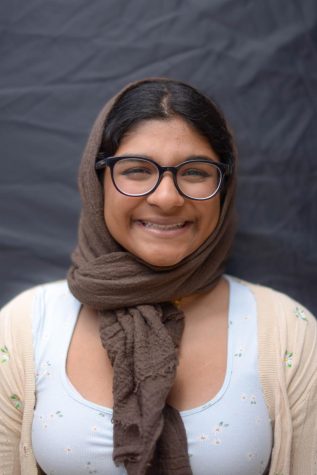‘A reality check’: Students share their personal stories with COVID-19
This article tells the stories of students’ personal experiences relating to the COVID-19 pandemic, including its impacts in sports, music and health. Solitude became our reality from March of 2020 to June of 2021 as the COVID-19 pandemic continued on, and more social connection has emerged out of the return to in-person learning this school year.
March 31, 2022
Small rectangular boxes fill the computer screen, each one carrying a familiar face, a friend or a teacher. The Zoom page serves as the only window to “normal” life. A day at the upper school, once filled with chatter before and after classes, lunchtime events, hands-on activities and social interaction became condensed into staring at a pixelated screen at home, connected to the upper school community online yet somehow still worlds away. This solitude became our reality from March of 2020 to June of 2021 as the COVID-19 pandemic continued on. Despite the challenges that remote learning brought, students like Student A realized the benefits that remote learning offered.
“Luckily, I have three siblings,” Student A said. “So I’m not just alone at home, and so that was kind of nice, that I got to hang out with my family members a little bit more. But [it was] definitely, definitely different. I guess schoolwork-wise, it was not as difficult because time management-wise, it was a lot easier for me because I didn’t have to go to basketball practice and games. I could really just focus on school.”
With the transition from remote learning to in-person learning this school year, Student A appreciates the return to more hands-on activities and more social connection, but the rise of the omicron variant has created more uncertainty surrounding in-person learning. The varsity girls basketball team, which Student A is a member of, traveled to Los Angeles over the winter break. After the trip, Student A and 7 team members tested positive for COVID-19; Student A experienced symptoms such as a headache, body aches, a sore throat and fatigue.
“I was already in school for a full day [before I tested positive], so one of my first concerns was that, ‘Oh my gosh, what if I gave it to all my friends and teachers and everybody,’ so I was freaking out a little bit about that,” Student A said. “But then the fact that some members of my family didn’t test positive, I feel like I got really lucky, and I didn’t spread it that much. I’ve been pretty careful about wearing a mask and everything, so none of my friends have it, which is a big relief to me.”
Isabella Lo (9) remembers feeling surprised by the unexpected news that she had contracted COVID-19 from the same basketball trip and exhausted by the long, boring days that followed where her mother would bring clothes and food up to her room while she stayed in isolation in her room.
Isabella, who contracted COVID-19 on Dec. 31 and returned to school on Jan. 10, also found the experience of returning back to school and staying caught up on assignments to be jolting — especially for classes like math where the class covered a lot of material every day. She felt that it was difficult to catch up on schoolwork, after days where she stayed in her room and in her backyard. To keep up with lessons, she received permission from some of her teachers to attend classes on Zoom.
“Hybrid learning is difficult,” Isabella said. “I found it difficult to continue learning because there’s no teacher to explain stuff for you. And teachers have different ways to handle this: in physics, I got to Zoom into class and keep learning but, in other classes, teachers just told me the work I had to do, which was hard because I was confused [about the new material].”
Robert Zhang (11) felt similarly jolted when he had to return back to quarantine, remembering the past semesters of online learning and experiencing again the feeling of isolation.
Robert, returning to school and his daily activities on Jan. 8 after contracting COVID-19 on Dec. 27, appreciated the care that his friends gave him throughout the process.
“Having to be in quarantine was pretty sad — I was a bit nervous when [the results of the COVID-19 test] first came back,” Robert said. “After the first week, it was definitely fine, and I like how supportive my friends were in checking in with me to make sure I’m okay.”
Nageena Singh (12) tested positive for COVID-19 on Dec. 27 after her eldest sister tested positive, and she quarantined over the winter break. Afterwards, her middle sister tested positive, but her parents both tested negative, creating the need for the sisters to quarantine from their parents, an experience that Nageena describes as “weird.”
“It was wearing masks around the house, making sure we didn’t expose my parents who somehow weren’t exposed in the first place,” Nageena said. “It was really weird because I had no symptoms. All of us have both vaccine shots and our booster shots, so fortunately, I didn’t have any symptoms. It was just weird, because I was stuck at home, but I didn’t feel like I was sick at all.”
After seven days of quarantine, she took another test, which came back negative.
Student A notes that the COVID-19 outbreak on the basketball team after returning from winter break significantly altered their practices and game schedule. Varsity girls basketball games for the weeks of Jan. 3 and Jan. 10 were postponed and at the time, many players were either quarantining or in the process of a new protocol that entailed specific exercises with athletic trainers to prepare them to play once more. According to upper school athletics director Dan Molin, Harker currently tests all indoor sports players for COVID-19 weekly.
Harker is also conducting weekly PCR COVID-19 tests for all indoor musicians and athletes. According to upper school director of instrumental music Dr. David Hart on Jan 18., there has been very little transmission of COVID-19 based on the results that have come back.
According to Hart, their recent winter instrumental concert, the first in-person concert in over two years, is a testament to the work that they have done over the course of the pandemic.
“Our concert Friday night was a culmination,” Dr. Hart said. “It represented two years of hard work on our students’ parts. We were over Zoom for a whole year and then previously for the second half of the second semester, which is when a lot of big concerts happen. Given all they’ve had to do to set up, rehearse outside, and turn in videos, I’ve never heard one complaint: that shows their resilience.”
Despite the various highs and lows that have accompanied the pandemic, the experience of testing positive for COVID-19 highlights the fact that this pandemic is not over yet.
“It kind of was just like a reality check,” Nageena said. “Even with all three vaccines and masks, and if your friends are vaccinated, you just feel instantly safer, but especially with omicron, breakthrough cases are much, much more common, and so it’s just kind of like a reality check.”


















![“[Building nerf blasters] became this outlet of creativity for me that hasn't been matched by anything else. The process [of] making a build complete to your desire is such a painstakingly difficult process, but I've had to learn from [the skills needed from] soldering to proper painting. There's so many different options for everything, if you think about it, it exists. The best part is [that] if it doesn't exist, you can build it yourself," Ishaan Parate said.](https://harkeraquila.com/wp-content/uploads/2022/08/DSC_8149-900x604.jpg)




![“When I came into high school, I was ready to be a follower. But DECA was a game changer for me. It helped me overcome my fear of public speaking, and it's played such a major role in who I've become today. To be able to successfully lead a chapter of 150 students, an officer team and be one of the upperclassmen I once really admired is something I'm [really] proud of,” Anvitha Tummala ('21) said.](https://harkeraquila.com/wp-content/uploads/2021/07/Screen-Shot-2021-07-25-at-9.50.05-AM-900x594.png)







![“I think getting up in the morning and having a sense of purpose [is exciting]. I think without a certain amount of drive, life is kind of obsolete and mundane, and I think having that every single day is what makes each day unique and kind of makes life exciting,” Neymika Jain (12) said.](https://harkeraquila.com/wp-content/uploads/2017/06/Screen-Shot-2017-06-03-at-4.54.16-PM.png)








![“My slogan is ‘slow feet, don’t eat, and I’m hungry.’ You need to run fast to get where you are–you aren't going to get those championships if you aren't fast,” Angel Cervantes (12) said. “I want to do well in school on my tests and in track and win championships for my team. I live by that, [and] I can do that anywhere: in the classroom or on the field.”](https://harkeraquila.com/wp-content/uploads/2018/06/DSC5146-900x601.jpg)
![“[Volleyball has] taught me how to fall correctly, and another thing it taught is that you don’t have to be the best at something to be good at it. If you just hit the ball in a smart way, then it still scores points and you’re good at it. You could be a background player and still make a much bigger impact on the team than you would think,” Anya Gert (’20) said.](https://harkeraquila.com/wp-content/uploads/2020/06/AnnaGert_JinTuan_HoHPhotoEdited-600x900.jpeg)

![“I'm not nearly there yet, but [my confidence has] definitely been getting better since I was pretty shy and timid coming into Harker my freshman year. I know that there's a lot of people that are really confident in what they do, and I really admire them. Everyone's so driven and that has really pushed me to kind of try to find my own place in high school and be more confident,” Alyssa Huang (’20) said.](https://harkeraquila.com/wp-content/uploads/2020/06/AlyssaHuang_EmilyChen_HoHPhoto-900x749.jpeg)









